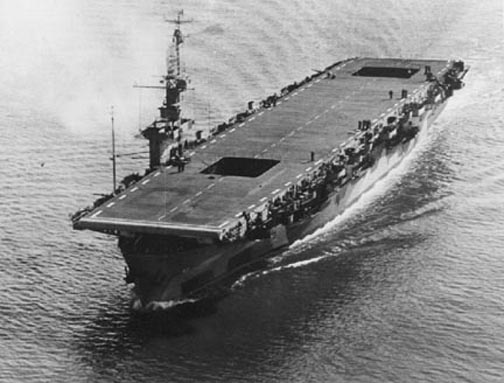 |
 |
| USS Wake Island (CVE-65) |
| Technical Data: Built by the Kaiser Shipbuilding Company of Vancouver, Washington, the escort carrier USS Wake Island was |
| commissioned on November 7, 1943. It had a length of 512 feet, three inches; a beam of 65 feet; entire width of 108 feet, one inch; |
| a draft of 22 feet, six inches; and a displacement of 7,800 tons. Reciprocating engines provided a top speed of 19 knots. She held |
| a compliment of 860 crew and 28 aircraft. |
| Service in World War II: Under the command of Captain Hames R. Tague, the Wake Island steamed through the Panama Canal |
| in January, 1944 and made port in Norfolk, Virginia, and New York before embarking on a voyage to Karachi, India. Upon returning, |
| the ship underwent alterations and overhaul in Norfolk before setting off June 15, 1944 for waters off Bermuda where she served as |
| nucleus of Task Group 22.6, a combined air-and-surface, anti-submarine hunter-killer expedition. On that cruise, one of the ship's |
| planes, an Avenger, intercepted and sank the German submarine U-543 off the coast of Africa. On August 4, Task Group 22.6 was |
| dissolved, and the Wake Island returned to Norfolk for repairs and alterations before moving on to Quonset, Rhode Island, where it |
|
served on carrier aircraft qualification duty from late August through the end of October. On November 11, the USS Wake Island |
|
returned to the west coast, via the Panama Canal, and continued on to Pearl Harbor, Hawaii, arriving on December 5, 1944. After |
|
taking on passengers and supplies, the Wake Island sailed for Manus in the Admiralty Islands where it discharged all passengers |
| and cargo and moved to join the huge fleet assembling for the invasion of Luzon. For most of January, February, and March, 1945, |
| the Wake Island participated in combat operations at Panay Gulf, Leyte Gulf, and Lingayen Gulf, in the Philippine Islands, as well |
| well as Iwo Jima in the Volcano Islands. Perhaps the highest praise of her performance came from Rear Admiral Clifton Sprague |
| who sent to the following message to the commanding officer of the Wake Island: "If your ship is as good as your air department |
| and squadron, it is a standout. I have seen nearly all of the combat CVE's work, and, I must say, the 'Wake' tops them all for |
| efficiency, smoothness, and good judgment. I hope we are together again." Charley Plummer disembarked the Wake Island on |
| March 18, 1945, and boarded the USS Admiral Coontz for transport to San Francisco and a well-deserved and long overdue shore |
| assignment. The USS Wake Island continued to see combat service in the Pacific, earning three battle stars before returning to |
| San Diego, California, on July 25, 1945, for training duty; but before her illustrious career ended, one more distinction awaited the |
| Wake Island. On November 5, 1945, the first ever jet-propelled landing on an aircraft carrier took place on her flight deck during |
| testing of the FR-1s "Fireball." The Wake Island was de-commissioned April 5, 1946 and struck from the Navy list April 17, 1946. |
| Charley Plummer's Story: The narrative above covers most major operations involving the USS Wake Island. To share a sailor's |
| view of combat, click here and read Chief Quartermaster Charley Plummer's own words describing daily activities of January 1945 |
| through March 1945, transcribed from a pocket diary he kept during his years at sea. |
| Ship's Itinerary (from Charley Madison Plummer's diary): click here. |
|
Sources: Dictionary of American Naval Fighting Ships; wartime diary of Chief Quartermaster Charley M. Plummer, U.S. Navy (1920-50). |
|
|